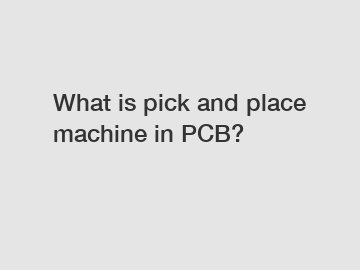What is pick and place machine in PCB?
In the dynamic world of electronics manufacturing, the demand for smaller, faster, and more intricate printed circuit boards (PCBs) continues to soar. To keep up with this ever-increasing need for precision, efficiency, and accuracy in circuit assembly, pick and place machines have emerged as an invaluable tool. This blog aims to demystify the workings of pick and place machines in PCB assembly, shedding light on their vital role and how they revolutionize the industry.
Unleashing Precision and Efficiency.
Pick and place machines, also known as SMT (Surface Mount Technology) machines, are robotic systems designed to automate the intricate process of placing electronic components onto a PCB. In the past, this task was done manually, leading to potential errors, inconsistencies, and substantial time consumption. However, with the advent of pick and place machines, manufacturers can now achieve unparalleled levels of precision, speed, and production efficiency.

The Basic Anatomy and Mode of Operation.
A pick and place machine consists of several key components that work cohesively to perform its task. These components include a feeder system, a placement head, a nozzle, a vision system, and a conveyor.
The process begins with the feeder system, which stores the electronic components, typically in the form of reels or trays. The machine then uses the placement head, equipped with a nozzle, to pick up individual components from the feeder system and accurately place them onto predetermined locations on the PCB. The vision system plays a crucial role in ensuring precise component positioning, as it captures images and uses pattern recognition algorithms to adjust the placement in real-time. Finally, the conveyor transports the PCBs along the assembly line, allowing for continuous production.
Revolutionizing PCB Assembly.
1. Precision and Accuracy:
Pick and place machines excel in their ability to handle miniature components, some as small as 0.2mm x 0.2mm. With their precise positioning capabilities, these machines ensure optimal alignment, minimizing the chances of short circuits, faulty connections, or compromised functionality.
2. Production Speed and Efficiency:
Explore more:Environmentally friendly solutions to plastic bottles under the microplastic crisis
Which Manual Stacker with Straddle Legs Provides the Smoothest Operation?
How do you straighten brake tubing?
What is the diameter of a hydraulic cylinder?
Revolutionize Adhesive Application with Efficient Hot Melt Dispensers
Exploring the Vital Role of Blowout Preventers
Which Innovative Features Make the Olvasztótégely Eladó the Perfect Choice for Modern Cooking?
By automating the component placement process, pick and place machines enable manufacturers to scale up production volumes significantly. The speed at which the machines can work, often placing hundreds of components per minute, dramatically reduces assembly time. This increased efficiency not only boosts productivity but also allows manufacturers to meet tight deadlines and fulfill customer demands promptly.
3. Flexibility and Adaptability:
To cater to the diverse range of component sizes, shapes, and types encountered in PCB assembly, pick and place machines offer flexible programming options. These machines can easily switch between different types of nozzles and feeders, enabling swift adaptation to varying production needs. This versatility empowers manufacturers to handle complex PCB designs without compromising quality or productivity.
4. Error Reduction and Quality Control:
Human errors are bound to occur, no matter how skilled the assembler is. However, pick and place machines minimize these errors by consistently placing components with precise accuracy. With the integration of advanced vision systems, these machines can detect defects, misalignments, or missing components, allowing for immediate corrective action. This advanced quality control ensures that each PCB adheres to industry standards and customer specifications.
5. Cost and Resource Optimization:
Though initial setup costs for pick and place machines may seem substantial, their long-term benefits significantly outweigh the investment. With reduced labor requirements, higher throughput, and minimized errors, the machines optimize resource allocation, such as manpower, time, and raw materials. This optimization translates into substantial cost savings over time for electronics manufacturers.
Conclusion.
In the fast-paced world of PCB assembly, pick and place machines have emerged as a game-changer. Combining precision, efficiency, and adaptability, these machines revolutionize the manufacturing process, setting new industry benchmarks. Their ability to handle intricate components, maintain high accuracy levels, improve production speed, and reduce errors make them an indispensable tool for electronics manufacturers striving for excellence. As PCB designs continue to evolve, the pick and place machine remains at the forefront of progress, driving innovation, and shaping the electronics industry of tomorrow.
If you want to learn more, please visit our website SMT machinery, Wholesale Labeling Device, SMT PCB Conveyor Wholesale.
Explore more:How does fish feed extruder work?
Revolutionary 30-1000LPM Oxygen Generator: Meet Your Medical & Industrial Needs Effortlessly
Who makes sintered porous metal filters?
How do I calculate how much air compressor I need?
Are lightweight wheels worth it cycling?
How much do CMM machines cost?
What's another word for detecting?










